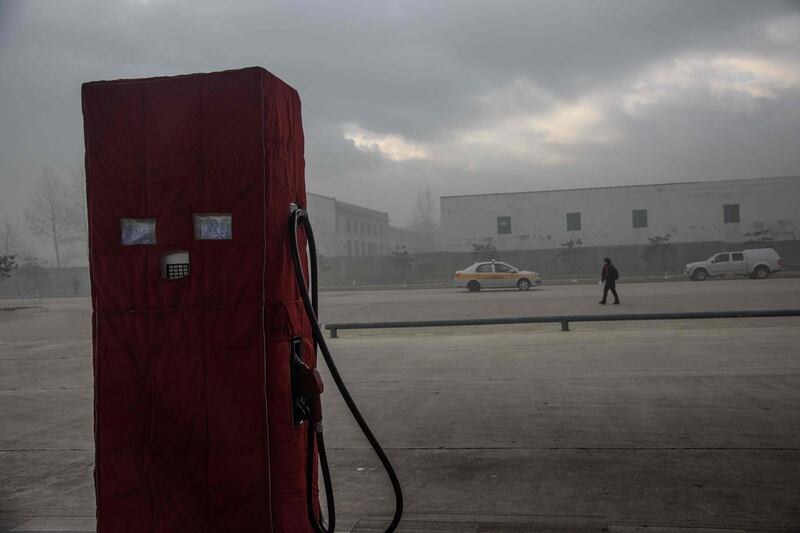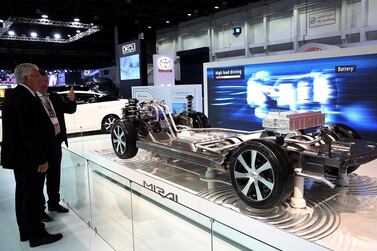There was little excitement in the air when China's State Council convened a press conference on March 15 to announce and explain 83 revisions to the annual Government Work Report. A few equity investors paid attention anyway. Among the revisions was a proposal to promote the development and construction of fueling stations for hydrogen fuel-cell cars. It was a Friday, and too late to trade on the news. On Monday, Chinese punters were ready: In the first few minutes of trading, fuel cell-related stocks gained more than $4 billion in market value, with several hitting their daily limits.
The bullishness lasted all week. It's likely to run for much longer. In less than a decade, the Chinese government has used subsidies and other policies to create the world's largest market for battery-powered electric vehicles. That market isn't without problems and limits, so the government is looking to diversify its bets on carbon-free transportation. Fuel cells, a technology that's being hotly pursued in other East Asian countries (as well as the US), is their favoured means of doing it. Chinese investors, having seen the opportunities created by the support for battery-electric vehicles, are right to get in early.
Fuel cells, like batteries, generate electricity that can drive a motor and vehicle. The similarities mostly stop there. Batteries are large, heavy and require charging by electricity that may or may not be generated from renewable resources. By contrast, fuel cells generate electricity (and, as a byproduct, heat and water) when hydrogen interacts with oxygen. They don't need charging; instead, they require onboard hydrogen tanks, which are both lighter and capable of holding far more energy than a battery (allowing them to travel further). And unlike batteries, which can require hours to charge, vehicles powered in this way can be refueled in minutes, similar to traditional internal combustion engines.
Of course, if it were so easy, hydrogen vehicles would already dominate battery-powered cars (and internal combustion engines, too). Several crucial bottlenecks have inhibited their growth. First, fuel cells are the most expensive components in the car, and for years they've made the technology un-competitive with battery electrics. For example, the Toyota Mirai – the Japanese company's signature fuel-cell vehicle – sells for around $70,000 (unsubsidised). Meanwhile, Chinese battery-electric vehicles can sell for less than $10,000.
Second, fuel cells might be clean-burning but hydrogen is often generated from fossil fuels, including coal. That's problematic if the goal is carbon reduction. And third, hydrogen infrastructure – everything from pipelines to fueling stations – is both expensive and rare. In China, the cost of a hydrogen station is around $1.5 million. That's a tough investment to make, especially when there are fewer than 5,000 fuel-cell vehicles operating in the country.
In the late 2000s, China's aspirations to become a battery-electric superpower faced equally steep hurdles. At the time, electric vehicles were all but nonexistent in the country, there was no charging infrastructure, and almost no indigenous technology or companies. In 2009, the government launched “Ten Cities, Thousand Vehicles”, a programme to stimulate electric-vehicle sales through large-scale pilots. A decade later, after tens of billions of dollars in subsidies and extensive policy support, China is the world's battery-electric king.
Can the nation repeat that feat with fuel cells? It's certainly going to try. As far back as 2015, the government targeted 1 million such vehicles on its roads by 2030. The ambition and momentum for fuel cells has picked up over the last year, as companies and cities commit to vehicles, technology and infrastructure. The first indication that something had changed came in January, when the state-backed Securities Journal reported that the government was preparing to re-launch the “Ten Cities” program for fuel-cell cars.
While it won't be easy, China has several advantages over competitors. First, it has policy stability (South Korea's hydrogen drive faltered in the mid-2000s due to a change in political leadership). Second, its world-beating renewable energy industry generates vast volumes of wasted energy that could be stored for other uses; that electricity can be used to create hydrogen, which can be stored and transported. Finally, China's deep pockets and willingness to spend on infrastructure with no immediate market bodes well for its commitment to (for now) unnecessary hydrogen fueling stations and associated installations.
Ultimately, success will require overcoming significant technical and market hurdles. China's success in building a battery-electric industry guarantees that it'll be in the race, if not the eventual leader, in this next stage in zero-carbon transport. For Chinese investors, that's a bet worth making.
Bloomberg







